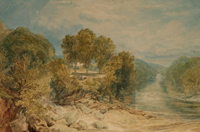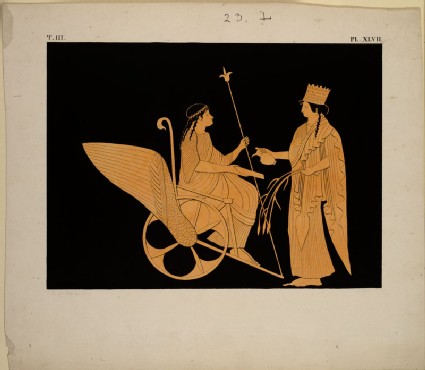Ruskin's Catalogue of Examples (1870)
Ruskin's first catalogue with notes containing his plans for the Standard, Reference and Educational series.

Ruskin's Catalogues: 1 object
Show search help- Reference URL
Actions
Print of the Decoration on a Greek Pelike, showing Triptolemus and Demeter Fourquemin
-
Ruskin text
23 K. Triptolemus and Demeter. Le Normand, tom. iii. pl. 47.From a vase of good time, but on the edge of decadence. He is here the spirit of agriculture generally, Demeter having the ears of corn in her own hand, and Triptolemus the floral sceptre. This Greek flower is the origin of all conventional forms of the Fleur-de-Lys, and it stands for all floral power in spring; therefore, in our series of mythic vegetation, since Triptolemus must by right have the ear of corn, we will keep the Fleur-de Lys with the violet, for Cora.
The germination of the seed is again sufficiently indicated in the serpent-crest; and the floor of the chariot, with the rod of the Fleur-de-Lys, takes the form of a ploughshare.
I give you this for its interest only; it is not good enough to copy; but you have now copies enough from Greek early design. We will work out the myths of the other gods, however, in due time.
-
Curator’s description:
Description
The lithograph shows Triptolemus sitting in his winged chariot and holding a long sceptre, opposite Demeter, who stands holding a small pitcher and some stems of wheat. It reproduces the decoration of a red-figure pelike then in the Königlich Museum in Berlin. It was plate XLVII in the third volume of Lenormant and de Witte's "Elite des monuments céramographiques", published in 1858. It was presumably taken from Ruskin's copy of the work now preserved in the Ruskin Library (inventory no. 1996B2621), which is missing many of its plates.
The print was catalogued by Ruskin in the "Catalogue of Examples" of 1870, as no. 23 K in the Educational Series, alongside other plates of Triptolemus and Demeter from Lenormant and de Witte. However, it did not reappear in any of his subsequent catalogues.
In his catalogue entry, Ruskin discussed the symbolism of Triptolemus's floral sceptre and Demeter's wheat-stalks, assigning the wheat to Triptolemus and the fleur-de-lys to Cora (Kore/Demeter). It was presented 'for interest only; it is not good enough to copy'.
-
Details
- Artist/maker
-
Fourquemin (active c. 1835 - c. 1861) (printer)L. Petit (active c. 1858) (lithographer)
- Object type
- Material and technique
- watercolour and bodycolour over lithograph on wove paper
- Dimensions
- 167 x 228 mm (stone); 251 x 289 mm (sheet)
- Inscription
- All printed, just outside the border of the image:
top left: T.III.
top right: PL. XLVII.
bottom left, very faint: Lith. de Fourquemin
bottom right, very faint: L. Petit
Recto, top just right of centre, in ink: 23 L
Verso, centre right, the Ruskin School's stamp
- Provenance
-
John Ruskin
- No. of items
- 1
- Accession no.
- WA.RS.EXAMPLES.ED.023.k
-
Subject terms allocated by curators:
Subjects
-
References in which this object is cited include:
References
Ruskin, John, Catalogue of Examples Arranged for Elementary Study in the University Galleries (Oxford: Clarendon Press, 1870), cat. Educational no. 23.K
Lenormant, Charles, and Jean de Witte, Elite des monuments céramographiques: Matériaux pour l'histoire des religions et des moeurs de l'antiquité, 4 vols in 8 (Paris: Leleux, 1844-1861), vol. III, pl. XLVII
Ruskin, John, ‘The Ruskin Art Collection at Oxford: Catalogues, Notes and Instructions’, Edward T. Cook and Alexander Wedderburn, eds, The Works of John Ruskin: Library Edition, 39 (London: George Allen, 1903-1912), 21
Location
-
- Western Art Print Room
Ruskin's Catalogues
-
Ruskin's Catalogue of Examples (1870)
23 K. Triptolemus and Demeter. Le Normand, tom. iii. pl. 47.From a vase of good time, but on the edge of decadence. He is here the spirit of agriculture generally, Demeter having the ears of corn in her own hand, and Triptolemus the floral sceptre. This Greek flower is the origin of all conventional forms of the Fleur-de-Lys, and it stands for all floral power in spring; therefore, in our series of mythic vegetation, since Triptolemus must by right have the ear of corn, we will keep the Fleur-de Lys with the violet, for Cora.
The germination of the seed is again sufficiently indicated in the serpent-crest; and the floor of the chariot, with the rod of the Fleur-de-Lys, takes the form of a ploughshare.
I give you this for its interest only; it is not good enough to copy; but you have now copies enough from Greek early design. We will work out the myths of the other gods, however, in due time.





